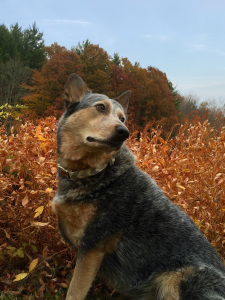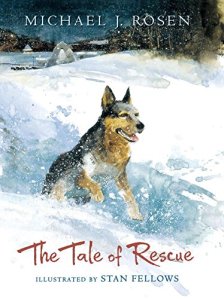The latest post in our series of author guest posts will appeal to dog lovers, poetry lovers, or anyone curious about where stories come from. In this post, Michael Rosen shares how his relationship with his dog shaped the story in his new novel, Tale of Rescue.
—
In 2012, I adopted a cattle dog that the good-hearted rescue group had named Shanti (“peace” in Sanskrit), yet pronounced “Shanty” (as in a sketchy sort of shack). Yeah, I couldn’t imagine calling either name over the next 12 or so years, so I came up with “Chant.”
 For several months, I dedicated myself to re-homing and socializing this anxious, intelligent animal, and to learning about and appreciating this particular breed and this particular individual. My twice-daily hikes through the woods offered opportunities to see this ecosystem I call my property through Chant’s senses and behaviors—especially to hear and to smell it…or, at least, to realize how much scent other creatures leave that I’d never noticed! As recognizable as my 100 acres have become over the last two decades, as well acquainted as I am with canine companions, Chant’s drive, alertness, and personality tuned me in to—or simply turned me towards—so much that I had never perceived.
For several months, I dedicated myself to re-homing and socializing this anxious, intelligent animal, and to learning about and appreciating this particular breed and this particular individual. My twice-daily hikes through the woods offered opportunities to see this ecosystem I call my property through Chant’s senses and behaviors—especially to hear and to smell it…or, at least, to realize how much scent other creatures leave that I’d never noticed! As recognizable as my 100 acres have become over the last two decades, as well acquainted as I am with canine companions, Chant’s drive, alertness, and personality tuned me in to—or simply turned me towards—so much that I had never perceived.
Part of this folded into my ongoing haiku practice: I’d compose observations of Chant on our walks—like snapping photographic stills—and try to frame them in words. But “frame” isn’t exactly correct, since that suggests a finished object that simply needs a more formal presentation. My haiku are more like sketches. Palimpsests. Versions or revisions of a seasonal instant.
under the dog’s chase
umber leaves repeat their fall
flying up again
Likewise, I wrote columns “from Chant” to post on Facebook. In those, she’d describe her life with Home (that would be me), soliloquizing about his curious, un-heeler-like nature (i.e., Home’s intolerance of a good roll on a dead possum, his dim sense of hearing, his pointless fascination with two-dimensional objects). In other words, a counterpoint to the soliloquies that run through dog people’s minds about our companions (i.e., Chant’s inability…to see me as separate from the all-day rain that keeps us from hiking; to accept the fact that some food within reach is the cats’; or to smile at the really sweet snapshot of her I just posted on Instagram.) (Yes, feel free to follow her there: hopewellsprings.)

But I also began a novel to absorb some of the “shock” from the iced-over days of that particularly hard winter, and much of what became The Tale of Rescuearose from my “apprenticeship” with this heeler.
It’s the story of a Florida family who comes to rural Ohio (yes, where Chant and I live) so their son can enjoy a week of a “real” winter. After days of snowy fun, they lose their way on a trek to a lodge in the already deep snow. A white-out overcomes them. Then icing rain. They’re exhausted, soaked, direction-less, and freezing in waist-deep snow. Eventually, a working cattle dog hears the father’s faint whistles. And, chapters later, she manages to rescue these strangers. Heroic…or just in a heeler’s nature?
The narrative is told omnisciently, with alternating sections from the cattle dog’s point of view or the unnamed family’s. As with the haiku and the columns about “life with Home,” the novel’s dual perspective issued from my enthralling and humbling apprenticeship to another creature.
Even for those who have no intention of writing or using the information, it’s an intriguing venture. There’s no technique other than to be deliberate, and I can liken it to breathing: You don’t have to consciously tell yourself to inhale and exhale, right? And yet you can intentionally slow, quicken, or hold a breath. The same goes for seeing: You can shift from the involuntary (nothing intentional, just the attention haplessly “grazing”) to the voluntary (training your attention on something specific, focusing, lingering).
Observing another creature can reveal what had been hidden—camouflaged: details and phenomena masked or obscured by expectations and common assumptions.
Here’s an example. I have two meadows that are kept mown. Hardly weeded-‘n’-seeded over the decades, these green spaces are simply whatever grows in full sunlight between two woods.
One morning the frost seemed—sounded—thicker than usual: crisper and slicker than previous frosts. In patches where the slenderest grasses dominate, white outlined each blade. (Truthfully, they looked as if a crew of folks with a glitter pen had spent all night on their hands and knees. Yes, the imagination comes up with corny stuff, too!) From the house to the pond, there were swathes of these pointed tips across the meadow’s slope. Witnessing this frost always reminds me of some aerial shot in a film of medieval warriors—legions, battalions, hordes of fighters with their weapons raised and ready to charge. But then, of course, the sun blasts over the hillside like the god such warriors would have considered it, and the god’s anger melts all the swords, arrows, and lances. And the warrior grasses head home, soaking wet, in peace…to raise their arms another day. So that’s just my imagination having its day in the sun, as it were.
But having the presence of my Australian Stumpy Tail Cattle Dog helps me visualize the meadow of frost-bright grasses as her blue coat. Each guard hair starts black at the skin but stands out white at the tip. The hairs poke out and backward like tiny silver quills. As Chant runs, they catch the morning sunlight and glisten, prism-like.
And then I notice the meadow is this very same blue in the shaded areas, but where the sun has shined, the grass has been “unsheathed” from the frost and the meadow presents its dulled winter green.
Finally, I chance to see how the heat of Chant’s paws melt the silver from the grass, even as my own steps, insulated in rubber boots, do not. So when I look across the meadow where we’ve trekked:
six footsteps crackle
across the silver-frost field—
leaving four green prints
An image, an idea that wasn’t possible without the voluntary looking through and with another creature’s presence. Just as Chant’s paws thawed the grasses, it warms my heart to witness this.
—
From the Publisher
About the Author: An acclaimed author, editor, and illustrator of some forty books for both adults and young people, Michael J. Rosen draws much of his inspiration from his lifelong experience with animals, whether as a college zoology major, a bird watcher, a dog trainer, or the founder of a granting program to help humane societies care for less fortunate cats and dogs. When he’s not writing, editing, or drawing, Michael J. Rosen likes to garden, cook, and collect—dog paraphernalia, of course. “I have lots of old dog books, sculptures, and pictures that kids and folk artists have made of their dogs, dog toys, old wooden dog-shaped door stops, and vintage dog pillows,” he says. “My office is just a kennel of drawn, carved, modeled, sewn, and colored dogs.” Born and reared in Columbus, Ohio, the author now lives with his family—which of course includes dogs and a cat—on ninety forested acres in central Ohio.
About Tale of Rescue: A family—a mother, a father, and their ten-year-old son—have come all the way from Florida to the Appalachian foothills to experience the wonder of a snowy weekend. At a nearby farm, a cattle dog is working, as she does every day, driving her forty head of cattle from pasture to corral and back again. And then, suddenly, a blizzard descends. The family is trapped outside, disoriented in the whiteout. They are panicked, exhausted, freezing, and stranded in waist-deep drifts. From off in the distance, the cattle dog has heard their faint, snow-drowned cries. Her inexhaustible attention turns to saving them. This stirring tale is both a compelling story of survival and a meditation on the tremendous will of man’s best friend.






